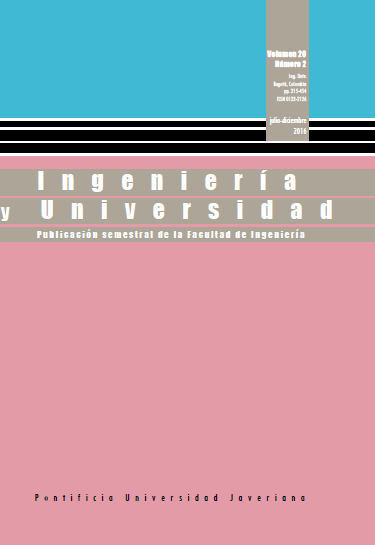Resumen
En este artículo se propone una modificación al algoritmo de perturbar y observar tradicional utilizado para el seguimiento del punto de máxima potencia en sistemas fotovoltaicos. El trabajo se encuentra justificado en la necesidad de disponer de algoritmos con los cuales encontrar el máximo global de potencia en paneles solares fotovoltaicos en conexión serie cuando están expuestos a condiciones de sombras parciales. El algoritmo propuesto realiza el seguimiento del máximo global de potencia y evita la búsqueda iterativa previa en máximos locales. El desempeño del algoritmo se evalúa por medio de simulaciones en el software PSIM y su funcionamiento se compara con el algoritmo de perturbar y observar tradicional, donde se evidencia la eficacia del algoritmo modificado en el seguimiento del máximo global bajo diferentes condiciones no uniformes de irradiancia y temperatura en el conjunto de paneles.
[2] B. Bendib, H. Belmili, and F. Krim, “A survey of the most used MPPT methods: conventional and advanced algorithms applied for photovoltaic systems,” Renew. Sust. Energ. Rev., vol. 45, no. 1, pp. 637-648, 2015. [Online]. Available: http://www.sciencedirect.com/science/article/pii/S1364032115000970
[3] M. A. G de Brito, L. Galotto, L. P Sampaio, G. de Azevedo, and C. A. Canesin, “Evaluation of the main MPPT techniques for photovoltaics applications,” IEEE Trans. Ind. Electron., vol. 60, no. 3, pp. 1156-1167, 2013. [Online]. Available: http://ieeexplore.ieee.org/stamp/stamp.jsp?tp=&arnumber=6196220
[4] S. S. W. Walker, N. K. Sooriyaarachchi, N. D. B. Liyanage, P. A. G. S. Abeynayake, and S. G. Abeyratne, “Comparative analysis of speed of convergence of MPPT Techniques,” in 2011 6th IEEE Int. Conf. Ind. Inf. Syst. (ICIIS), 2011, pp. 522-526. [Online]. Available: http://ieeexplore.ieee.org/stamp/stamp.jsp?tp=&arnumber=6038125
[5] M. A. G. de Brito, L. Galotto, L. P. Sampaio, G. de Azevedo, and C. A. Canesin, “Comparative analysis of MPPT techniques for PV applications,” in 2011 Int. Conf. Clean Electr Power (ICCEP), 2011, pp. 99-104.
[6] H. Rezk and A. M. Eltamaly, “A comprehensive comparison of different MPPT techniques for photovoltaic systems,” Solar Energy, vol. 112, no. 1, pp. 1-11, 2015. [Online]. Available: http://www.sciencedirect.com/science/article/pii/S0038092X14005428
[7] M. A. Eltawil and Z. Zhao, “MPPT techniques for photovoltaic aplications,” Renew. Sust. Energ. Rev., vol. 25, no. 1, pp. 1-11, 2013. [Online]. Available: http://www.sciencedirect.com/science/article/pii/S1364032113003250
[8] A. Dolara et al., “Energy comparison of seven MPPT Techniques for PV Systems,” J. Electromagnet Anal. Appl., vol. 1, no. 3, pp. 152-162, 2009. [Online]. Available: http://www.scirp.org/journal/PaperInformation.aspx?PaperID=725
[9] A. Al-Diab and C. Sourkounis, “Variable step size P&O MPPT algorithm for PV systems,” in 2010 12th Int. Conf. Optim. Elect. Electron. Equipment (OPTIM), 2010, pp. 1097-1102.
[10] M. A. Abdourraziq, M. Ouassaid, M. Maaroufi, “Comparative study of MPPT using variable step size for photovoltaic systems,” in 2014 Second World Conference on Complex Systems (WCCS), 2014, pp. 374-379.
[11] F. A. O. Aashoor and F. V. P. Robinson, “A variable step size perturb and observe algorithm for photovoltaic maximum power point tracking,” in 2012 47th Int. Univ. Power Eng. Conf. (UPEC), 2012, pp. 1-6.
[12] M. Hassani, S. Mekhilef, A. P. Hu, N. R. Watson. “A novel MPPT algorithm for load protection base on output sensing control,” in 2011 IEEE Ninth Int. Conf. Power Electron. Drive Syst. (PEDS), 2011, pp. 1120-1124 [Online]. Available: http://ieeexplore.ieee.org/stamp/stamp.jsp?tp=&arnumber=6147400
[13] A. Sayal, “MPPT techniques for photovoltaic system under uniform insolation and partial shading conditions,” in 2012 Students Conf. Eng. Syst. (SCES), 2012, pp. 1-6.
[14] R. Alonso, P. Ibáñez, V. Martínez, E. Ramón, and A. Sanz, “An innovative perturb, observe and check algorithm for partially shaded PV systems,” in 13th Eur. Conf. Power Electron. Appl., 2009, pp. 1-8.
[15] E. Durán, M. Sidrach, J. Galán, and J. M. Andujar, “Comparative analysis of buck-boost converters used to obtain I-V characteristic curves of photovoltaic modules,” in IEEE Power Electron. Specialist Conf., 2008, pp. 2036-2042.
[16] S. J. Chiang, H. Shieh, and M. Chen, “Modeling and control of PV charger system with SEPIC converter,” IEEE Trans. Ind. Electron., vol. 56, no. 11, pp. 4344-4353, 2009. [Online]. Available: http://ieeexplore.ieee.org/stamp/stamp.jsp?tp=&arnumber=4631374
[17] M. Marodkar, S. Adhau, M. Sabley, and P. Adhau, “Desing and simulation of DC-DC converters for photovoltaic system based on Matlab,” in 2015 Int. Conf. Ind. Instru. Control (ICIC), 2015, pp. 1478-1483.
[18] M. Killi and S. Samanta, “Output voltage sensor based maximum power point tracking for PV system using SEPIC,” in 2015 IEEE Int. Conf. Ind. Technol. (ICIT), 2015, pp. 1112-1116.
[19] R. F. Coelho et al., “Analytical and experimental analysis of DC-DC converters in photovoltaic maximum power point tracking applications,” in 36th Ann. Conf. on IEEE Ind. Electron. Soc. (IECON(, 2010, pp. 2778-2783.
[20] J. J. Nedumgatt et al., “Perturb and observe MPPT algorithm for solar PV systems –modeling and simulation,” in 2011 Ann. IEEE India Conf. (INDICON), 2011, pp. 1-6.
[21] L. Hassaine, “Implementación de un control digital de potencia activa y reactiva para inversores: aplicación de sistemas fotovoltaicos conectados a la red,” Ph.D. dissertation, Departamento de Tecnología Electrónica, Universidad Carlos III de Madrid, Leganés, España, 2010.
Una vez aceptado un trabajo para publicación la revista podrá disponer de él en toda su extensión, tanto directamente como a través de intermediarios, ya sea de forma impresa o electrónica, para su publicación ya sea en medio impreso o en medio electrónico, en formatos electrónicos de almacenamiento, en sitios de la Internet propios o de cualquier otro editor. Este uso tiene como fin divulgar el trabajo en la comunidad científica y académica nacional e internacional y no persigue fines de lucro. Para ello el autor o los autores le otorgan el permiso correspondiente a la revista para dicha divulgación mediante autorización escrita.
Todos los articulos aceptados para publicación son sometidos a corrección de estilo. Por tanto el autor /los autores autorizan desde ya los cambios sufridos por el artículo en la corrección de estilo.
El autor o los autores conservarán los derechos morales y patrimoniales del artículo.


